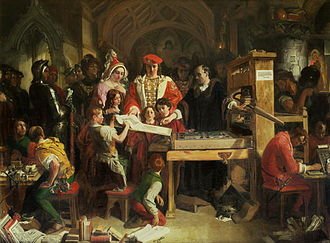William Caxton: A project that didn’t work – and how it was rescued
What happened at first?
William Caxton
Inventor of the Printing Press
A teacher working with a group of gifted students knew that they were all gifted and passionate readers. Wanting to create a research project that aligned with their interests, she decided to ask them to research William Caxton, inventor of the printing press, sure that this would enthuse them – the man without whom all their reading would never have become possible! To her surprise, her students found the project totally boring.
Why?
Think about what the project asked the students to do! Where’s the challenge to their thinking? Where’s the room for initiative and originality? Basically it’s your typical classroom project – look it up, record what you find, present it nicely. Nothing wrong with this – just boring.
Alternative questions
Here’s another approach, a different set of tasks:
Chart every single thing you read over the next 24 hours.
Work with everyone in the class or group to build a maxi-chart of your combined reading over 24 hours.
What conclusions can you draw about the role of reading in our lives?
Imagine that you had never learned to read.
What would you miss most about not being able to read?
In what other ways would your life be different if you had not learned to read?
Discuss: What would it be like to live in a time when most people did NOT learn to read?
-Some prompt questions for the teacher to use:
How would people send messages to each other?
How would you remember things like recipes and other sets of instructions?
How would children learn?
How would you find your way to a place you had not been to before?
How would news travel?
Discuss: Would it be more or less scary to live in a society where you and most other people could not read than it is to live in today’s society where almost everyone can read?
Discuss: Who would hold the power in a society where most people could not read? Would the ability to read have any influence on this?
Research! Why was it that at one time in history, almost no-one learned to read? What changed that?
After children have found out about Caxton’s printing press, invite the following discussion:
Caxton’s printing press made it possible to print an infinite number of copies of almost any book.
How do you suppose people who could already read felt about that? Would they be totally thrilled? What concerns might they have about everyone else being able to learn how to do this too?
How do you suppose non-readers felt? Would they be totally thrilled? Would they have any concerns?
Why did this work better?
It was concerned with an activity of genuine and strong interest for these students.
It allowed for practice of research skills.
But also:
It began with a hands-on activity that got students engaged.
It linked directly to what they knew and had experienced.
It challenged them to think outside the square and, especially, to examine critically something they may previously have taken for granted.
It explored philosophical issues, asked them to consider issues from different perspectives, and gave opportunities to express different points of view.
In other words, it was a learning opportunity constructed to take account of the typical learning approach of the gifted student and the way in which it differs from that of most students.© Rosemary Cathcart www.giftedreach.org.nz
Click here to download the PDF of this activity for use with your own children or students!


